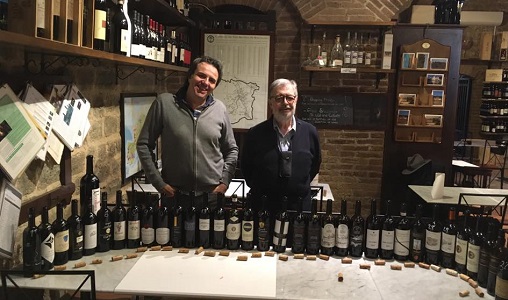Brunello di Montalcino 2015 Preview (1)

2015: a great, multifaceted year that exalts Montalcino’s territorial and climatic diversity.
We went to Montalcino in November on a partial reconnaissance mission to find out about the much-anticipated Brunello di Montalcino 2015. The vintage will be commercially “released” on January 2, while its official Italian presentation will take place during the Benvenuto Brunello (Welcome Brunello) event.
During the years it sat maturing, various tastings from the barrel confirmed that the great interest in this vintage was absolutely justified. Overall weather conditions during the year were good and, as is always the case with good years, the harvest was late in the more northern areas and in the norm in the southern ones. Harvest took place between September 15 and October 15, depending on the warmth of the zone.
Some Anglo-Saxon gurus have compared this vintage with their favorite years, a demonstration of how, as usual, they have a lot of enthusiasm and little knowledge regarding the evolution of those years which they evaluated so highly when when they came out. Comparisons with the years 1997, 2000 and 2007 are truly inappropriate and the product of a muscular and tannic trait of Sangiovese that has never convinced us, this because it shows the aromatic limits of precocious bottle aging with dark notes that have little to do with the great Brunello vintages. The great vintages were 1999, 2001, the fresh 2004 and 2006 that still today have a nice acidity, fresh bouquet and are still centered on the fruit, but without the jam, chickpea, tamarind and bark notes that afflict the wines from vintages the gurus have singled out.
Vintage 2015 is different and particular thanks to nature and the experience of producers. Some, unfortunately, made the mistake of seeking more mature tones without paying attention to how the bouquet will degenerate due to the burned grapes that were not adequately eliminated during harvest nor in the winery. These grapes were burned due to a premature falling of the protective leaves from the vine. Nevertheless, this was obviously not the case for all the over 250 producers. What stands out is that the skilled producers have become even more skilled and are growing in number, while the others seem stuck in a rigid method of wine growing and winemaking that is too rooted in a tradition that was established in years past when climate conditions were different than they are today.
The weather in 2015 had high temperatures that were more evident in southern zones, where yield suffered, while northern Montalcino reaped all the benefits from the late, traditional nature of the year. Even the light rains of early October were nicely absorbed by the grapes that then had time to find a new balance in the weeks before harvest. This resulted in a harvest that was easier to carry out in the northern areas than in the southern ones. The harvest used selection methods that were both mechanical and optical on the sorting tables and the greater attention paid to the grape rather than the bunch made a difference. This in regard to the tonality of the color, which was even more bright and lively, the tannins and, above all, the cleanliness and intensity of the fruit aromas that withstood maturing in wood and maintained the wine’s extremely interesting freshness and complexity.
For those who worked well, using science, experience and the right amount of technology, this was a wonderful vintage.
A bitter-sweet anecdote. American journalist James Suckling declared Montalcino the best area in the world for winemaking in 2015, awarding 11 Brunello 2015 with the highest rating of 100/100. While I am happy about this on one side, given my love for this area, I am unhappy that the number of wines with 100 points were greater than those rated 99 (only two) and 98 (four), something that is statistically very improbable. I hope and fear that there is not too much enthusiasm over those 100-point wines because this poses a dilemma: how many top-rates wines will there be for vintage 2016, which many producers say is even better?
In conclusion, I would like to sincerely express our gratitude to those producers who sent us samples to evaluate and to Fabio Tassi and his La Fortezza wine shop for the assistance he offered during the tastings. Everything was done with great professionalism and readiness to help. A personal thanks goes to Fabrizio Bindocci, President of the Consorzio del Brunello di Montalcino, for the interest he showed towards our initiative and his efforts, made vain by the red tape of the various commissions, to connect it with the consortium.
Tomorrow and the day after we will publish the classification of the 20 wines that impressed our panel - headed by editor-in-chief Daniele Cernilli and that included managing editor Stefania Vinciguerra and yours truly- in this partial tasting of vintage 2015.

 Italiano
Italiano







